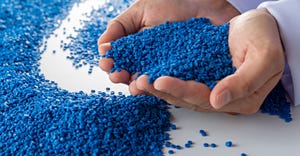By Design: Designing thinner parts
September 29, 1998
In this bimonthly column, Glenn Beall eall Plastics Ltd. (Libertyville, IL) shares his special perspective on issues important to design engineers and the molding industry.
Editor's note: In the August 1998 issue of IMM, Glenn Beall discussed the management issues that surround thin-wall molding. In this article, issues for designers of thin-wall parts are outlined.
Reducing a molded part's thickness in order to reduce its cost is not a new idea. All through the 1990s, the concept of thin-walling has been widely promoted as a cost reduction technique. The change in electronics from mainframe to personal computers, followed by the laptop and notebook computers, has provided the incentive that drives this trend. Today, portable electronic products, especially cell phones and pagers, are pushing thin-walling to the limits of the available plastic materials and the injection molding process.
Trial and Error
It was the advent of single-use, disposable products and throw-away packaging that paved the way for the thin-walling of durable products. Packaging designers have always had an incentive to reduce cost by using less plastic material. They also have the opportunity to repeatedly redesign the same product in order to create a new marketplace image. In the beginning, they had no prior experience, and they designed their first parts on the safe side, with a thickness of .060 inch. Based on experience, the redesigned package had a wall thickness of .050 inch. The third revision went to market with a wall thickness of only .040 inch.
As packaging designers were experimenting with thinner and thinner walls, their injection molding and plastic material suppliers were learning how to give their customers what they were asking for. Today, it seems as though each new generation of disposable and durable products has a thinner wall than its predecessor. In some respects, the plastic housings for personal computers, pagers, or cell phones are nothing more than packages for their electronic components. The designers of these durable products have benefited from the pioneering efforts of their packaging counterparts.
Thin-walling means different things to different people. To someone designing patio or office chairs, thin-walling could be a reduction in thickness from .250 to .220 inch. The engineer who designs portable laptop computers interprets thin-walling differently than the engineer who designs stationary desktop personal computer housings. Designers of stationary electronic products are now reducing the standard wall thickness of .125 inch to .090 or .080 inch. The really thin parts, such as cell phones and pagers, are now down in the .030- to .050-inch-thick range.
The plastic material used to produce a molded part represents a significant portion of that component's total cost. It is a given that the least amount of the lowest cost material that will do the job is the best. The minimum amount of plastic material that can be used to produce a product is limited by two primary considerations. The overriding consideration is that the product must function as required. At the same time, the part has to be capable of being efficiently molded. In some cases, the wall thickness of a part is dictated by functional requirements. In other cases, the wall thickness must be increased to allow for molding.
Material Considerations
Once a new design has progressed to the point that the engineer can see its size and shape, the designer should pause and give consideration to the selection of a suitable material. All plastic materials have different flow characteristics. The crystalline materials such as polypropylene and high density polyethylene, which are favorites of the packaging industry, generally have higher flow properties than the amorphous thermoplastics. The high-molecular-weight, high-performance materials have higher melt viscosities, and they will not flow as far as low-molecular-weight materials.
Manufacturers of engineering materials have responded to this situation by producing intermediate-molecular-weight materials. These materials are a trade-off between ease of flow and strength. One of these specially compounded materials may be the ideal material for a new thin-wall application. Material manufacturers and experienced molders are excellent sources of information on what can and cannot be achieved.
Injection molding is a melt flow process. There is a minimum wall thickness required for a specific material to flow through and properly fill a part of a given size and shape. In the old days, designers were guided by their past experiences or by studying what was being accomplished by others. Today, computer-aided mold filling analysis can be used to determine the precise minimum allowable wall thickness for good molding. In the past, these analytical tools were of limited value, as they were not programmed to accommodate the extremely rapid cavity filling rates required for really thin-wall molding. Most of the major software suppliers have now overcome this limitation.
Once the designer has selected a plastic material, it is possible to determine a minimum wall thickness that will allow for the efficient molding of that part. Once the designer knows the minimum moldable wall thickness, it is possible to proceed with finalizing the design of the part.
Strength Considerations
The chosen wall thickness will also determine the minimum material and molding costs. The next major issue is to determine whether or not that minimum wall thickness will be robust enough to satisfy all of the product's functional requirements. In some cases, the thickness of the wall will have to be increased in order to provide enough stiffness or impact strength.
The wide acceptance of three-dimensional, solid model CAD drawing and the ability to progress on into finite element analysis (FEA) have reduced structural design to a science. The designer who takes advantage of these technologies can eliminate the guesswork in determining the minimum acceptable wall thickness for a molded part. FEA
also saves on material cost by eliminating the common practice of overspecifying the wall thickness.
The stiffness of a plastic part is determined by its shape and the strength of the plastic material. Reducing a part's thickness by only a small amount will result in a major loss in stiffness, which is proportional to the cube of the part's thickness. By the same token, a slight increase in wall thickness will result in a large increase in stiffness. The increase in wall thickness will also represent an increase in material and molding costs.
Another way of achieving added stiffness is to upgrade to a stronger plastic material. In most cases, this will also result in a higher cost. Stiffness can also be increased by redesigning a flat surface with domes or crowns. Another approach is to design the product in such a manner that large, flat walls are supported by some sort of internal structure. The correct use of ribs can also increase stiffness, while minimizing the amount of material being used. Ribs do take up space, and the minimum size requirements of portable electronic devices often precludes their use. Many other products do not have this limitation.
Impact strength is also a concern with thin-wall parts. Impact strength is a complex subject, but the two primary considerations are choosing a good impact grade of material and controlling the geometry. Sharp corners are stress concentrators that can destroy the impact resistance of the best of materials. Radiused corners distribute stresses over a broader area and increase a part's resistance to rapidly applied loads. In the case of thin-wall parts, careful attention must be given to eliminating sharp corners on both the inside and outside surfaces of a part.
Design Details
Details such as ribs, bosses, and gussets are projections off a part's nominal wall. In order to prevent unsightly sink marks in the nominal wall, these projections have traditionally been designed to be 50 to 75 percent of the wall thickness, depending on the material being molded. These design guidelines are now being revised to accommodate thin-wall molding. With wall thicknesses of .050 inch or less, there can be a loss in packing pressure at the end of the flow path.
In these locations, projections should be designed to be 50 to 60 percent of the nominal wall thickness. Near the gate, the cavity packing pressures are high. Projections located in this area can be 75 to 100 percent of the nominal wall thickness. As with conventional molding, it is advisable to design projections to the minimum thickness. The welding-up and remachining of a cavity is always more costly than increasing the size of an existing cavity. This is what is called designing to be tool safe.
The high injection pressures required for thin-wall parts mean the plastic material will be tightly packed into all the little nooks and crannies of the cavity. Small tool marks or pitted EDM'd surfaces become significant undercuts. All surfaces on a thin-wall part cavity must be smoothly polished.
Thin-wall parts require a minimum draft angle of one degree per side. This important rule applies to all surfaces that are perpendicular to the parting line. The cavities that form ribs, bosses, louvers, and side actions must all be drafted in order to ensure efficient demolding. Thin-wall parts are very susceptible to being deformed by a mold's ejection mechanisms. Smoothly polished, drafted surfaces reduce ejection forces, molding cost, and the possibility of distortion. Packaging and portable electronic devices may have paved the way, but thin-walling is now available to anyone who is willing to follow the rules.
You May Also Like


